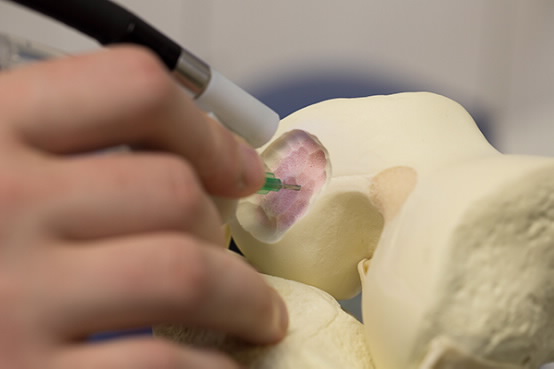Researchers at University of Wollongong (UOW), Australia has developed a new device using the 3 D printing technology known as BioPen. The latest technology will give the surgeons the power to design tailored implants directly at the injury spot and during surgery. Earlier surgeons had tough time finding matching tissues or body parts during surgeries and transplants. Using this hand held BioPen, creating even new bones identical to individual patient will now be possible.
To make the bone replacement the 3D bio-printer makes a frame in the bone shape and then fills it with stem cells. The 3D Printing BioPen ink consists of polylactic acid (a polymer providing strength to the bone) blended with material like seaweeds extract (act as a cushioning compound around the cells) known as alginate. The amalgam is sheathed in a gel, which can be applied in layers on the injury site forming a 3D scaffold. A low intensity ultra violet light, later solidifies the gel thus protecting the enclosed cells in each layer.
The cells thus incorporated at the injury spot start multiplying and separate as nerve cells, bone cells or muscle cells. These individual cells will proliferate into colony of cells forming a functional tissue as muscle or nerves to name a few. The devise can be used in implanting live cells and other growth factors expediting the growth and recovery of bone and cartilage. The 3 D printing and the pen like grip gives surgeons better eye for precision during complex surgery and are easy in transportation from one place to other.
The devise is being tested by Professor Peter Choong at St Vincent’s Hospital Melbourne for making the best use of cell materials during clinical trails. In Professor Choong and Professor of Surgery Sir Hugh Devine (at University of Melbourne) said:
This type of treatment may be suitable for repairing acutely damaged bone and cartilage, for example from sporting or motor vehicle injuries. Professor Wallace’s research team brings together the science of stem cells and polymer chemistry to help surgeons design and personalize solutions for reconstructing bone and joint defects in real time.
The BioPen will definitely going to reduce the time required in recovery apart from making possible treating injuries, which were perceived as impossible earlier. In future, we may see BioPen treating burns and deep cut without leaving any scar to remember or making tailored body parts eliminating the need for artificial parts.
Source: ZME Science




